城市规划英文版
- 格式:doc
- 大小:64.50 KB
- 文档页数:5
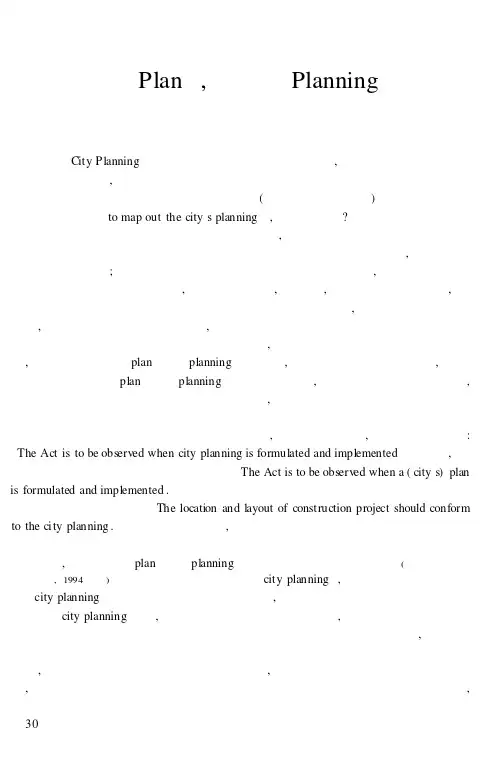
是“Plan”,还是“Planning”黄润娟英文“City Planning”这个词语译成汉语是“城市规划”,这个词语是城市规划专业中最常见的术语,也是中译英文章以及我们许多规划师在与外国城市规划师交流中极易译错的术语。
《中华人民共和国城市规划法》(以下简称《规划法》)英译本将“制订城市规划”译成“to map out the city,s planning”,这样译对吗?王宗炎先生在《辨义为翻译之本》一文中说道,“翻译是转述而非创作”。
转述就是用另一种语言准确无误地把原作的原意表达出来。
翻译标准“信、达、雅”,“信”是译文内容方面的标准;“达”和“雅”则是文字语句即形式方面的要求,它们是一个整体的两个方面。
而在这三个因素中,首要的是“信”,没有信,即没有了作者的本意,文字语句译得再好也毫无意义。
所以在翻译过程中首要任务是辨义,即要从文法上掌握字与字,字群与字群关系上的一些规律,又要在特定语境中寻求每个字或字群在句子中的相对价值。
要准确地翻译“城市规划”这个词组,就应首先弄清“城市规划”的确切意思,透彻地理解英文“plan”和“planning”的不同,造成这个术语误译的原因,一方面是没有辨析英文“plan”和“planning”语义上的差异,另一方面是没有吃透原文,没有将“城市规划”这个术语置于特定的语境中,全面正确地理解原意。
辨义不清和理解不透必然表达不当。
《规划法》第二条中“制定和实施城市规划,必须遵守本法”,英译本的译文是:“The Act is to be observ ed when city planning is formulated and implemented”这样译,与规划法的原意不符。
其准确的译法应该是“The Act is to be observ ed when a(city,s)plan is formulated and implemented.”《规划法》第三十条“建筑工程的选址和布局必须符合城市规划。
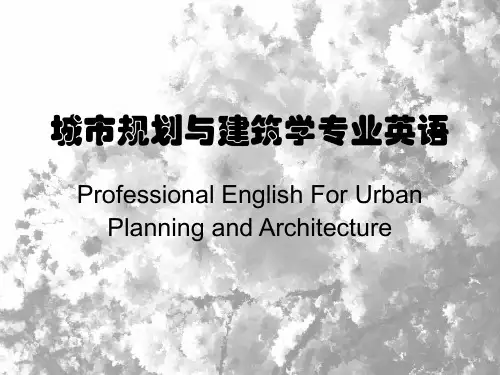
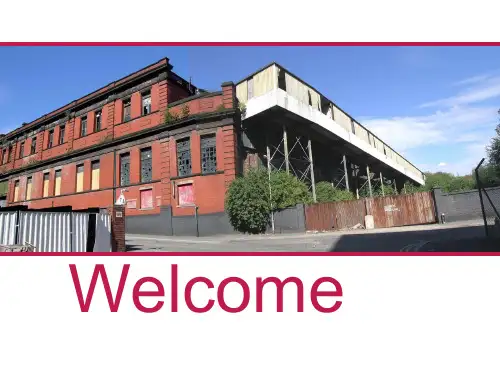
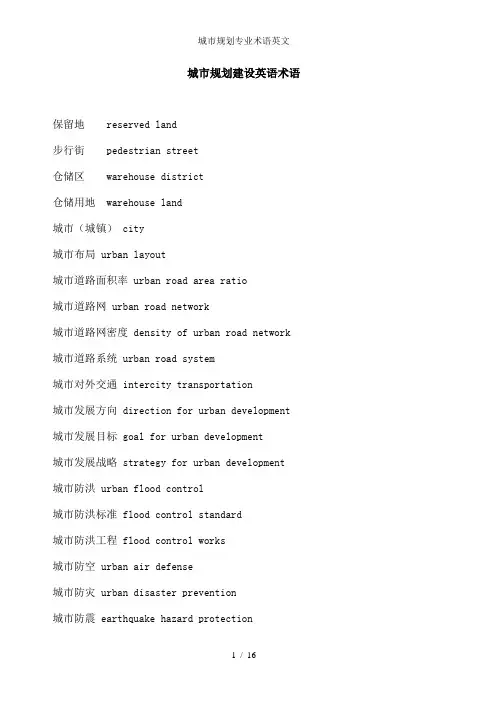
城市规划建设英语术语保留地 reserved land步行街 pedestrian street仓储区 warehouse district仓储用地 warehouse land城市(城镇) city城市布局 urban layout城市道路面积率 urban road area ratio城市道路网 urban road network城市道路网密度 density of urban road network 城市道路系统 urban road system城市对外交通 intercity transportation城市发展方向 direction for urban development 城市发展目标 goal for urban development城市发展战略 strategy for urban development城市防洪 urban flood control城市防洪标准 flood control standard城市防洪工程 flood control works城市防空 urban air defense城市防灾 urban disaster prevention城市防震 earthquake hazard protection城市给水 water supply城市给水工程 water supply engineering城市给水系统 water supply system城市工程管线综合 integrated design for utilities pipelines 城市功能分区 functional districts城市供电电源 power source城市供电系统 power supply system城市供热系统 district heating system城市规划 urban planning城市规划法规 legislation on urban planning城市规划管理 urban planning administration城市规划建设管理 urban planning and development control城市规划区 urban planning area城市规划用地管理 urban planning land use administration城市规模 city size城市化 urbanization城市化水平 urbanization level城市环境保护 city environmental protection城市环境污染 city environmental pollution城市环境质量 city environmental quality城市环境质量评价 city environmental quality assessment城市基础设施 urban infrastructure城市集中供热 district heating城市建成区 urban built-up area城市交通 urban transportation城市交通预测 urban transportation forecast城市结构 urban structure城市绿地系统 urban green space system城市绿化 urban afforestation城市排水 sewerage城市排水工程 sewerage engineering城市排水系统 sewerage system城市群 agglomeration城市燃气 gas城市燃气供应系统 gas supply system城市人口机械增长率 mechanical growth rate of population 城市人口结构 urban population structure城市人口年龄构成 age composition城市人口预测 urban population forecast城市人口增长 urban population growth城市人口增长率 urban population growth rate城市人口自然增长率 natural growth rate城市设计 urban design城市生态平衡 balance of city ecosystem城市生态系统 city ecosystem城市通信 communication城市通信系统 communication system城市污水 sewage城市详细规划 detailed plan城市消防 urban fire control城市形态 urban morphology城市性质 designated function of city城市用地 urban landunban planning 城市规划town planning 城镇规划act of urban planning 城市规划法urban comprehensive planning 城市总体规划urban detailed planning 城市详细规划Residentiral district detailed planning 修建性详规regulatory detailed planning 控制性详规规划类的专业课程reginal planning 区域规划urban system planning 城镇体系规划urban sociology 城市社会学urban economic城市经济学urban geograghy 城市地理学urban infrastructure planning 城市基础设施规划(water supply and drainage \electricity supply\road building)(城市供水、供电、道路修建)urban road system and transportation planning 城市道路系统和交通规划urban road cross-section城市道路横断面urban management information system 城市管理信息系统GIS =geograghy information system 地理信息系统RS=remote sensing遥感Gardening==Landscape architecture 园林=营造景观学Urban landscape planning and design 城市景观规划和设计Urban green space system planning城市绿地系统规划Urban design城市设计·Land-use planning土地利用规划The cultural and historic planning 历史文化名城Protection planning保护规划Urbanization城市化Suburbanization郊区化Public participation公众参及Sustainable development(sustainability) 可持续性发展(可持续性)Over-all urban layout城市整体布局Pedestrian crossing人行横道Human scale人体尺寸(sculpture fountain tea bar)(雕塑、喷泉、茶吧)Traffic and parking交通及停车Landscape node景观节点·Brief history of urban planningArchaeological 考古学的Habitat 住处Aesthetics 美学Geometrical 几何学的Moat 护城河Vehicles 车辆,交通工具,mechanization 机械化merchant-trader 商人阶级urban elements 城市要素plazas 广场malls 林荫道·The city and regionAdaptable 适应性强的Organic entity 有机体Department stores 百货商店Opera 歌剧院Symphony 交响乐团Cathedrals 教堂Density 密度Circulation 循环Elimination of water 水处理措施In three dimensional form 三维的Condemn 谴责Rural area 农村地区Regional planning agencies 区域规划机构Service-oriented 以服务为宗旨的Frame of reference 参考标准Distribute 分类Water area 水域Alteration 变更Inhabitants 居民Motorway 高速公路Update 改造论文写作Abstract 摘要Key words 关键词Reference 参考资料·Urban problemDimension 大小Descendant 子孙,后代Luxury 奢侈Dwelling 住所Edifices 建筑群<Athens Charter>雅典宪章Residence 居住Employment 工作Recreation 休憩Transportation交通Swallow 吞咽,燕子Urban fringes 城市边缘Anti- 前缀,反对……的;如:antinuclear反核的anticlockwise逆时针的Pro- 前缀,支持,同意……的;如:pro-American 亲美的pro-education重教育的Grant 助学金,基金Sewage 污水Sewer 污水管Sewage treatment plant 污水处理厂Brain drain 人才流失Drainage area 汇水面积Traffic flow 交通量Traffic concentration 交通密度Traffic control 交通管制Traffic bottleneck 交通瓶颈地段Traffic island 交通岛(转盘)Traffic point city 交通枢纽城市Train-make-up 编组站Urban redevelopment 旧城改造Urban revitalization 城市复苏·Urban FunctionUrban fabric 城市结构Urban form 城市形体Warehouse 仓库Material processing center 原料加工中心Religious edifices 宗教建筑Correctional institution 教养院Transportation interface 交通分界面CBD=central business district 城市中心商业区Public agencies of parking 停车公共管理机构Energy conservation 节能Individual building 单一建筑Mega-structures 大型建筑Mega- 大,百万,强Megalopolis 特大城市Megaton 百万吨R residence 居住用地黄色C commercial 商业用地红色M manufacture 工业用地紫褐色W warehouse 仓储用地紫色T transportation 交通用地蓝灰色S square 道路广场用地留白处理U utilities 市政公共设施用地接近蓝灰色G green space 绿地绿色P particular 特殊用地E 水域及其他用地(除E外,其他合为城市建设用地)Corporate 公司的,法人的Corporation 公司企业Accessibility 可达性;易接近Service radius 服务半径·Urban landscapeTopography 地形图Well-matched 相匹配Ill-matchedVisual landscape 视觉景观Visual environment 视觉环境Visual landscape capacity 视觉景观容量Tour industry 旅游业Service industry 服务业Relief road 辅助道路Rural population 城镇居民Roofline 屋顶轮廓线风景园林四大要素:landscape plantarchitecture/buildingtopographywater·Urban designNature reserve 自然保护区Civic enterprise 市政企业Artery 动脉,干道,大道Land developer 土地开发商Broad thorough-fare 主干道·Water supply and drainageA water supply for a town 城市给水系统Storage reservoir 水库,蓄水库Distribution reservoir 水库,配水库Distribution pipes 配水管网Water engineer 给水工程师Distribution system 配水系统Catchment area 汇水面积Open channel 明渠Sewerage system 污水系统,排污体制Separate 分流制Combined 合流制Rainfall 降水Domestic waste 生活污水Industrical waste 工业污水Stream flow 河流流量Runoff 径流Treatment plant 处理厂Sub-main 次干管Branch sewer 支管City water department 城市供水部门·UrbanizationSpatial structure 空间转移Labor force 劳动力Renewable 可再生*Biosphere 生物圈Planned citiesBlueprints 蓝图License 执照,许可证Minerals 矿物Hydroelectric power source 水利资源Monuments 纪念物High-rise apartment 高层建筑物Lawn 草地Pavement 人行道Sidewalk 人行道Winding street 曲折的路·A view of VeniceMetropolis 都市Construction work 市政建设Slums 平民窟Alleys 大街小巷Populate 居住Gothic 哥特式Renaissance 文艺复兴式Baroque 巴洛克式。

城市和城市化2.0.1 居民点 settlement人类按照生产和生活需要而形成的集聚定居地点。
按性质和人口规模,居民点分为城市和乡村两大类。
2.0.2 城市(城镇)city以非农不业和非农业人口聚集为主要特征的居民点。
包括按国家行政建制设立的市和镇。
2.0.3 市 municipality; city经国家批准设市建制的行政地域。
2.0.4 镇 town.经国家批准设市建制的行政地域。
2.0.5 市域 administrative region of a city城市行政管辖的全部地域。
2.0.6 城市化 urbanization人类生产和生活方式由乡村型向城市型转化的历史过程,表现为乡村人口向城市人口转化以及城市不断发展和完善的过程。
又称城镇化、都市化。
2.0.7 城市化水平 urbanization level衡量城市化发展程度的数量指标,一般用一定地域内城市人口占总人口的比例来表示。
2.0.8 城市群 agglomeration一定地域内城市分布较为密集的地区。
2.0.9 城镇体系 urban system一定区域内在经济、社会和空间发展上具有有机联系的城市群体。
2.0.10 卫星城(卫星城镇)satellite town在大城市市区外围兴建的、与市区既有一定距离又相互间密切联系的城市。
城市规划概述3.0.1 城镇体系规划 urban system planning一定地域范围内,以区域生产力合理布局和城镇职能分工为依据,确定不同人口规模等级和职能分工的城镇的分布和发展规划。
3.0.2 城市规划 urban planning对一定时期内城市的经济和社会发展、土地利用、空间布局以及各项建设的综合部署、具体安排和实施管理。
3.0.3 城市设计 urban design对城市体型和空间环境所作的整体构思和安排,贯穿于城市规划的全过程。
3.0.4 城市总体规划纲要master planning outline确定城市总体规划和重大原则的纲领性文件,是编制城市总体规划的依据。
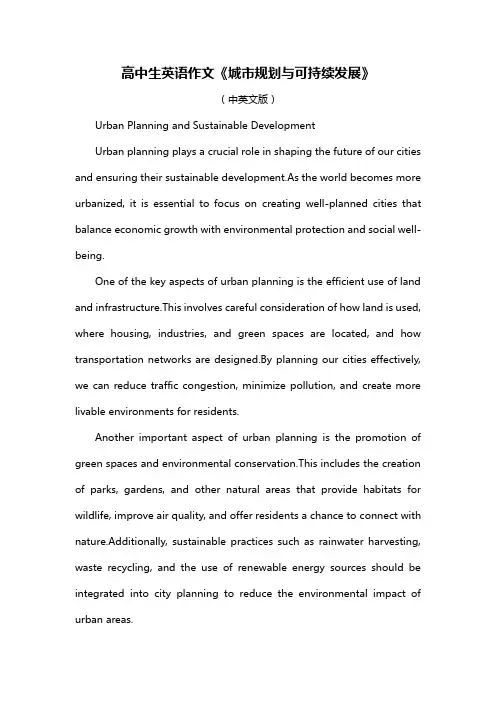
高中生英语作文《城市规划与可持续发展》(中英文版)Urban Planning and Sustainable DevelopmentUrban planning plays a crucial role in shaping the future of our cities and ensuring their sustainable development.As the world becomes more urbanized, it is essential to focus on creating well-planned cities that balance economic growth with environmental protection and social well-being.One of the key aspects of urban planning is the efficient use of land and infrastructure.This involves careful consideration of how land is used, where housing, industries, and green spaces are located, and how transportation networks are designed.By planning our cities effectively, we can reduce traffic congestion, minimize pollution, and create more livable environments for residents.Another important aspect of urban planning is the promotion of green spaces and environmental conservation.This includes the creation of parks, gardens, and other natural areas that provide habitats for wildlife, improve air quality, and offer residents a chance to connect with nature.Additionally, sustainable practices such as rainwater harvesting, waste recycling, and the use of renewable energy sources should be integrated into city planning to reduce the environmental impact of urban areas.Furthermore, urban planning should also focus on social equity and inclusivity.This means ensuring that all residents have access to basic services such as healthcare, education, and transportation, regardless of their socio-economic status.It also involves creating diverse and vibrant communities where people of different backgrounds can live, work, and interact harmoniously.In conclusion, urban planning is essential for creating sustainable and livable cities.By carefully considering land use, promoting green spaces, and focusing on social equity, we can build cities that are environmentally friendly, economically prosperous, and socially inclusive.With effective urban planning, we can ensure a better future for ourselves and future generations.。


建筑和城规专英词语中英文版————————————————————————————————作者:————————————————————————————————日期:ﻩaesthetics 美学山墙gable老虎窗dormercirculation流线pedestrian/vehicular circulationPorte-cochere可停车马的门廊Skylight 天窗finish 装修完成面悬挑cantilever立面elevation/facadeorder柱式landscape architecture景观建筑plumbing给排水(工程)archvs. dome 拱穹的区别剪力shear、shearing force弯矩momentbasement vs.foundation 地下室、基础mezzanine 夹层concrete vs. reinforcedconcretestructurevs. construction 结构与构造Art Nouveau 新艺术运动Artsand CraftsMovementeclecticism折衷主义Ecole des Beaux-Arts公立美术学院urban infrastructure城镇基础设施urbanization 城市化publictransit 公共交通government-subsidizedhousing政府补贴房economicrestructuring 经济体制改革grass-root movement 草根运动建筑红线propertylinecentralbusiness district 中央商务区zoning plan 区域规划edge city边缘城市neighborhood 邻里polycentriccity 多中心城市urbanregeneration 城市更新community社区megalopolis 大都市megacity大都市site planning总平面设计建设场地规划agglomeration effects 聚集效应城市群效应legislation法律法规blueprint蓝图discretion 自由裁量权regulatory 调整的, 规管density 密度intensity强度capacity承受量容许承载力tenement房屋公寓公共住宅ecological footprint 生态足迹urbanplanning 城市规划aspects of planning 规划性质规划方向slums 贫民窟vista景色景观urban form城市形态ﻫurban decay城市衰败ﻫurbanreconstructionand 城市重建urban renewal城市更新transport交通ﻫsuburbanization郊区化environmentalfactors 环境因素settlement 定居点built environment 城市环境建成环境social environment社会环境urbanized area 城市化地区municipality自治区直辖市regional planning区域规划ﻫre-generationof inner city老城更新旧城改造infrastructural decay 基础设施衰败feasibility可行性合理性settlement layout 小区规划agriculture 农业population人口pre-Classical ages 前古典时期Classical ages 古典时期organic urbanform 有机城市形态developed countries 发达国家the industrialized city 工业城市wealthyelite 富豪精英citizen 市民the concept ofgardencity 花园城市概念modernism 现代主义skyscraper building 摩天大楼freeway 高速公路快速路the towers setwithin gardens format 花园城市形式下的高楼Ville Contemporaine现代城市large-scale plan 大尺度的规划government-subsidized housing政府补贴房human scale 人体尺度vitality of the community 社会生命力social problem社会问题plannedneighborhood 规划过的邻里关系ﻫindividualism个人主义diversity 多样性post-modernist era 后现代时代sustainable development 可持续发展sustainability可持续性consumption消耗量灭绝natural resource 自然资源ecosystemdestruction生态系统破坏urban heat islands 城市热岛social inequality 社会不平等climate change 气候变化sustainable city 可持续城市urban character城市特征localidentity 地方认同感heritage 遗产pedestrianfriendly步行友好traffic交通utility 公用设施natural hazard 自然灾害zoning 区域growth management 增长管理planning techniques规划技术smartgrowth 智能增长emergency evacuationroute 紧急疏散路线accessibility可达性design-out crime 可排除的犯罪traffic calming 交通冷静化The deliberateslowing of traffic inresidential areasbybuilding speed bumps or other obstructionspedestrianisation步行化environmental determinism 环境决定论ﻫJane Jacobs雅格布森eyeson the street concept街道的眼睛criminal behavior犯罪行为rapid urbanization 快速城市化slumhabitation贫民区policy ofclearance清理政策ﻫdepopulation人口减少economic restructuring 经济体制改革property abandonment 放弃产权unemployment rate失业率demography 人口统计学ghetto犹太人聚居区central urban 中心城市real estate 房产不动产ﻫreal estatevalue房产价值awider variety of housing choices 更多的住屋选择infrastructure基础设施sewerage排污排水系统density of an urbanenvironment 城市环境密度road traffic公路交通parking space 停车场parking garages车库highdensityarea高密度地区ﻫbuilt-up area建成区urbantransit 城市交通ﻫtransit oriented development 公交导向发展multilane boulevard 多车道路migration 迁移rural areas郊区hinterland腹地内地偏远地区congestion交通拥堵commuting 通勤来往environmental protection andconservation 环境保护、Sustainability Appraisal可持续性评估quantitative tool量化工具Sidewalk人行道planning process 规划过程top-down自上而下的规划grass root 草根developer 开发人员project-basedplanning 基于项目的规划transportation hub 交通枢纽military bases 军事基地wilderness荒地ﻫadministrative 行政管理functional 功能性的polycentrism多中心主义macro level 宏观角度ﻫflood plain冲积平原earthquake fault地震断层transportation corridor运输通道hubsand spokes 枢纽与放射状的道路waste disposal垃圾处理ﻫGreen Belt绿化带amalgamation 城市的合并与兼并building codes 建筑规范zoninglaws and policies 分区法律政策zoningordinances 区划条例landuse 土地利用natural environment 自然环境builtenvironment 建成环境land use types土地使用类型land management 土地管理United Nations联合国landuse planning 土地使用规划centralplanning 中心区规划biodiversity 生物多样性comprehensive planning全面规划综合规划landvalues 土地价值transportationplanning交通规划bikelanes自行车道rational planning model理性规划模式a multi-disciplinary approach跨专业的方式vehiculartraffic 车辆交通automobiledependency 汽车依赖predominant 主导的主要的traffic flow 交通流signalized crossings 交叉路口trafficlight交通灯cyclist 骑自行车的人public transit公共交通streetcar (tram)有轨电车电车modes of transport运输方式traffic volume 交通量parkinglots停车场drive-in bank免下车银行non-renewableresource不可再生资源greenhousegas 温室气体global warming 全球变暖gatedcommunity 封闭式社区physical separation 物质隔离NewUrbanism新城市主义Smart growth 精明增长physical urban design物质的城市设计urbandensity 城市密度mobility 流动性机动性accessibility 可达性land-use regulation 土地使用管理ﻫbuilding height建筑高度lotcoverage 覆盖率permitting system许可制度ﻫlocal government当地政府legislation法律法制open space 开放空间setbacks 挫折挫败landscaped space 景观空间paved space 带道路的空间Floor AreaRatio (FAR)容积率total building squarefootage(building area)总建筑面积sitearea 总平面面积场地面积ﻫregulatory control 法律控制discretionarycontrol自行决定的控制discretion自由裁量权real property房产不动产personal property动产个人财产personal property law 个人财产法律geographic information system(GIS) 地理信息系统ﻫremote sensing 遥感ﻫIndustrialRevolution 工业革命GDP (gross domestic product) 国民生产总值per capita 每人Squalor 贫困肮脏middle class 中产阶级economicsystem生态系统means ofproduction生产方式central economic planning 中央的经济规划freemarket自由市场urban agglomeration 城市群conurbation 集合城市城市群有卫星城的大都市suburbanization 郊区化urban sprawl 城市扩张satellitecommunities 郊外居住区greenbelt绿化带commuting通勤交通edge cities 边缘城市sustainable urbanism可持续的城市主义cityblock 街区urban fabric 城市肌理'streetwalls' of public space 公共空间的靠街道的墙Lot土地地段cul-de-sac road 尽端路neighborhood unit 邻里单位pedestrianstreet 步行街perimeter block边缘街区setback 挫折propertyboundary红线public utilities公共设施thoroughfare 大街eminent domain (美)土地征用权immovable property 不动产realproperty动产housing subdivision居住单元governance 管理social housing社会住房affordable housing 经适房not-for-profit organizations 非营利机构non-profit organizations非营利机构compact city 紧凑型城市walkableplace 可步行的空间transit ridership 公共交通乘客pedestrian crossing人行横道mixed-usedevelopment 综合开发urban socialexclusion 城市社会的不相容multi-sectoredpartnership多部门的合作关系community participation公众参与public participation 公众参与urbanregeneration 城市更新statutory plan 法定图则pluralism 多元化political representatives 政治代表segregation隔离social stratification社会分化社会阶层化social mobility 社会流动性socialinequality 社会不平等。
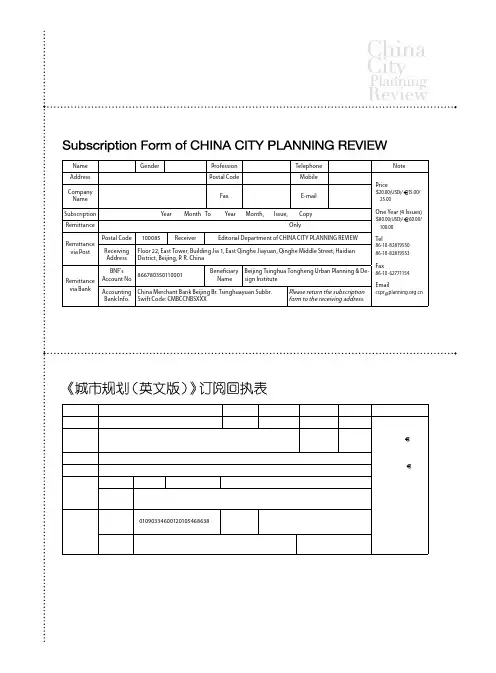
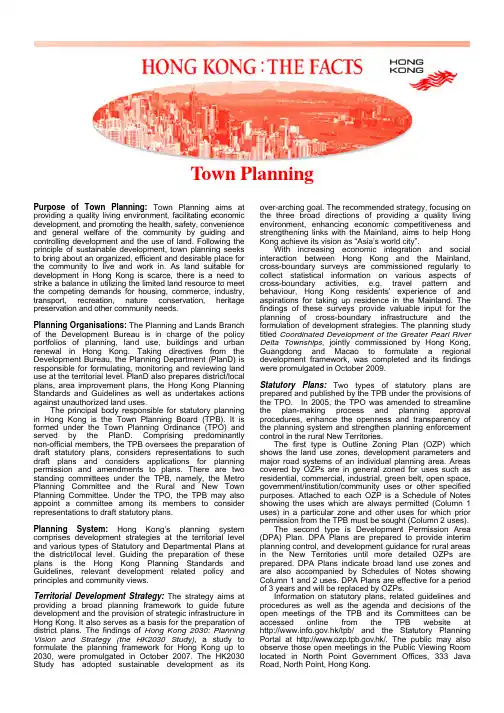
Town PlanningPurpose of Town Planning: Town Planning aims at providing a quality living environment, facilitating economic development, and promoting the health, safety, convenience and general welfare of the community by guiding and controlling development and the use of land. Following the principle of sustainable development, town planning seeks to bring about an organized, efficient and desirable place for the community to live and work in. As land suitable for development in Hong Kong is scarce, there is a need to strike a balance in utilizing the limited land resource to meet the competing demands for housing, commerce, industry, transport, recreation, nature conservation, heritage preservation and other community needs.Planning Organisations: The Planning and Lands Branch of the Development Bureau is in charge of the policy portfolios of planning, land use, buildings and urban renewal in Hong Kong. Taking directives from the Development Bureau, the Planning Department (PlanD) is responsible for formulating, monitoring and reviewing land use at the territorial level. PlanD also prepares district/local plans, area improvement plans, the Hong Kong Planning Standards and Guidelines as well as undertakes actions against unauthorized land uses.The principal body responsible for statutory planning in Hong Kong is the Town Planning Board (TPB). It is formed under the Town Planning Ordinance (TPO) and served by the PlanD. Comprising predominantly non-official members, the TPB oversees the preparation of draft statutory plans, considers representations to such draft plans and considers applications for planning permission and amendments to plans. There are two standing committees under the TPB, namely, the Metro Planning Committee and the Rural and New Town Planning Committee. Under the TPO, the TPB may also appoint a committee among its members to consider representations to draft statutory plans.Planning System: Hong Kong’s planning system comprises development strategies at the territorial level and various types of Statutory and Departmental Plans at the district/local level. Guiding the preparation of these plans is the Hong Kong Planning Standards and Guidelines, relevant development related policy and principles and community views.Territorial Development Strategy:The strategy aims at providing a broad planning framework to guide future development and the provision of strategic infrastructure in Hong Kong. It also serves as a basis for the preparation of district plans. The findings of Hong Kong 2030: Planning Vision and Strategy (the HK2030 Study), a study to formulate the planning framework for Hong Kong up to 2030, were promulgated in October 2007. The HK2030 Study has adopted sustainable development as its over-arching goal. The recommended strategy, focusing on the three broad directions of providing a quality living environment, enhancing economic competitiveness and strengthening links with the Mainland, aims to help Hong Kong achieve its vision as “Asia’s world city”.With increasing economic integration and social interaction between Hong Kong and the Mainland, cross-boundary surveys are commissioned regularly to collect statistical information on various aspects of cross-boundary activities, e.g. travel pattern and behaviour, Hong Kong residents’ experience of and aspirations for taking up residence in the Mainland. The findings of these surveys provide valuable input for the planning of cross-boundary infrastructure and the formulation of development strategies. The planning study titled Coordinated Development of the Greater Pearl River Delta Townships, jointly commissioned by Hong Kong, Guangdong and Macao to formulate a regional development framework, was completed and its findings were promulgated in October 2009.Statutory Plans:Two types of statutory plans are prepared and published by the TPB under the provisions of the TPO. In 2005, the TPO was amended to streamline the plan-making process and planning approval procedures, enhance the openness and transparency of the planning system and strengthen planning enforcement control in the rural New Territories.The first type is Outline Zoning Plan (OZP) which shows the land use zones, development parameters and major road systems of an individual planning area. Areas covered by OZPs are in general zoned for uses such as residential, commercial, industrial, green belt, open space, government/institution/community uses or other specified purposes. Attached to each OZP is a Schedule of Notes showing the uses which are always permitted (Column 1 uses) in a particular zone and other uses for which prior permission from the TPB must be sought (Column 2 uses).The second type is Development Permission Area (DPA) Plan. DPA Plans are prepared to provide interim planning control, and development guidance for rural areasin the New Territories until more detailed OZPs are prepared. DPA Plans indicate broad land use zones and are also accompanied by Schedules of Notes showing Column 1 and 2 uses. DPA Plans are effective for a periodof 3 years and will be replaced by OZPs.Information on statutory plans, related guidelines and procedures as well as the agenda and decisions of the open meetings of the TPB and its Committees can be accessed online from the TPB website at .hk/tpb/ and the Statutory Planning Portal at .hk/. The public may also observe those open meetings in the Public Viewing Room located in North Point Government Offices, 333 Java Road, North Point, Hong Kong.Departmental Plans: Outline Development Plans and Layout Plans are administrative plans prepared within the framework of the statutory plans. With a much larger scale, these departmental plans show more detailed level planning parameters e.g. site boundaries, location of access points and footbridges, specific types of government or community uses to facilitate the coordination of public works, land sales and land reservation for specific uses.Views from the public are essential considerations for the formulation of development strategies and preparation of plans. Public engagement in the form of public forums, workshops, exhibitions, etc. has become a very important component of the planning process.Hong Kong Planning Standards and Guidelines: It is a reference manual setting out the criteria for determining the scale, location and site requirements of various land uses and facilities. It is used in the preparation of town plans and planning briefs and is a tool that helps to regulate development.Urban Renewal and Regeneration: The Urban Renewal Authority (URA) is a statutory body established in 2001 to speed up the renewal of old urban areas and to execute the Urban Renewal Strategy formulated by the Government. PlanD co-ordinates with the URA under the statutory provisions in the planning of urban renewal and regeneration projects for the improvement of the old urban areas.The Government has launched a review of the Urban Renewal Strategy in 2008 in three stages – envisioning, public engagement and consensus building, and is scheduled for completion in 2010. The Strategy will provide a broad policy guidance for urban renewal in Hong Kong.New Town and New Development Areas: Large-scale new town development in the New Territories began in the early 1970s. PlanD’s District Planning Offices have worked closely with the Civil Engineering and Development Department’s Development Offices to prepare plans and oversee the development of these new towns. At present, nine new towns, namely, Tsuen Wan, Sha Tin, Tuen Mun, Tai Po, Yuen Long, Fanling/Sheung Shui, Tseung Kwan O, Tin Shui Wai and North Lantau are in various stages of development and will accommodate about four million people upon full development. However, large-scale new towns will not be pursued in the foreseeable future. Instead, medium-scale new development areas such as Kai Tak and new development areas in the New Territories will be developed.Planning Enforcement: The Town Planning Ordinance provides the Planning Authority with enforcement power against unauthorized developments (UDs) within the DPAs or the replacement OZPs. Within these areas, all developments are unauthorized unless the development is either in existence before the gazettal of the DPA Plans, permitted under the Plan or covered by valid planning permissions.PlanD’s Central Enforcement and Prosecution Section is responsible for undertaking enforcement and prosecution actions against the UDs. They investigate complaints and referrals from the public or other Government departments, and carry out regular patrols to identify possible UDs. Once a UD is confirmed, statutory enforcement and prosecution actions will be taken as appropriate. Topical Studies: PlanD also carries out a wide range of topical studies. In the light of a slower population growth projected for the next 30 years, greater planning efforts are now focused on improving the quality of the living environment and local area improvements, particularly for the older urban cores and the harbourfront.For local areas, the Pedestrian Plans for Causeway Bay, Tai Po Market and Kwun Tong, Area Improvement Plan for Tsim Sha Tsui and the Area Improvement Plan for Shopping Areas of Mongkok have been completed. Two studies on enhancing the rural township of Lau Fau Shan and Sha Tau Kok and surrounding areas are in progress. Other ongoing studies include a feasibility study on Urban Climatic Map and Standards for Wind Environment, and Air Ventilation Assessment studies for specific areas and sites.The harbour planning framework formulated under the Harbour Plan Study is now being reviewed to take into account the changing public aspirations of the harbourfront. The review is conducted in close association with the Harbour-front Enhancement Committee, an advisory committee representing a wide range of interests in the community. The harbour planning principles and guidelines have been completed and promulgated. For the waterfront areas, the Kai Tak Planning Review has been completed. and The Urban Design Study for the New Central Harbourfront is near completion and the Hong Kong Island East Harbourfront Study is ongoing.In order to formulate a planning framework to guide the future use of the large area to be released from the Frontier Closed Area, PlanD commenced a planning study titled Land Use Planning for the Closed Area to examine the development and conservation potentials of the area. The study is scheduled for completion in 2010. With a view to formulating a planning framework for the Kwu Tung North, Fanling North and Ping Che/T a Kwu Ling NDAs to address the long term housing and employment needs in Hong Kong, the North East New Territories New Development Areas Planning and Engineering Study was launched in June 2008.ThePlanning and Engineering Study on Development of Lok Ma Chau Loop, a joint effort of Hong Kong and Shenzhen, commenced in June 2009. The main objective of the Study is to formulate a comprehensive plan for development and implementation of the developments and infrastructure in the Loop as well as the area in its vicinity for the mutual benefits of both Hong Kong and Shenzhen.The Planning Study on Liantang/Heung Yuen Wai Cross-boundary Control Point and its Associated Connecting Road in Hong Kong which aims to examine the planning, land, traffic, environmental and engineering issues of the new crossing and its associated connecting road has been completed. Implementation of the new crossing has commenced and is expected to complete in 2018.Planning Information: There is a Hong Kong Planning and Infrastructure Exhibition Gallery located at G/F, Murray Road Multi-storey Car Park Building showcasing Hong Kong’s planning proposals and major infrastructure projects. For more information on town planning, please visit PlanD’s website at .hk/or visit the two Planning Enquiry Counters located at:- 17/F, North Point Government Offices,333 Java Road, North Point, Hong Kong- 14/F, Sha Tin Government Offices,1 Sheung Wo Che Road, Sha Tin, New TerritoriesFor enquiries, please call 2231 5000, fax to 2877 0389 or e-mail to enquire@.hk.Published by the Information Services Department, Planning Department Home Page address:Hong Kong Special Administrative Region Government .hkGovHK Website: .hkInformation contained in this publication may be freely used.No acknowledgement is necessary.January 2010。
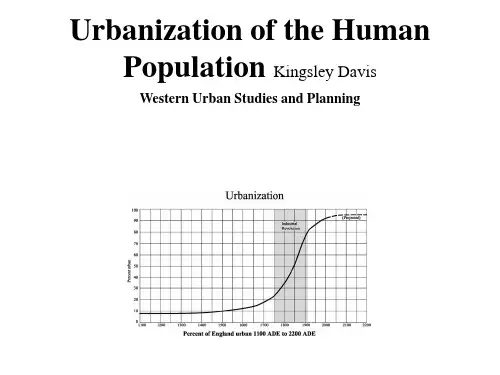
城市规划12本杂志1、《城市规划》杂志2、《城市规划学刊》3、《国际城市规划》杂志(原名《国外城市规划》)该期刊为目前国内唯一一份介绍国外城市规划理论与实践的国家级专业刊物,建设部优秀期刊,面向国内外公开发行。
每期一个主题:对于城市规划的重点和热点进行深入系统的专题研究。
海外信息速递:提供海外最新理论和实践的发展动态。
栏目文章:涵盖城市规划和建设领域的各个层面。
4、《规划师》杂志5、《上海城市规划》由上海市城市规划管理局主办,为双月刊。
6、《中国城市规划》(英文版)杂志,可能就是《城市规划》的英文版。
7、《城市问题》杂志8、《城市发展研究》杂志,该杂志是国家级专业学术性期刊。
国内外公开发行。
自1994年创刊以来,根据国家经济发展战略,立足专家学者,面向城市决策者,架起专家学者与决策者之间的桥梁,为城市的健康发展而奋斗。
主要业务范围是刊载国内外城市科学研究成果,最新城市发展理论和城市发展趋势,对城市规划、建设、管理和城市总体发展方面的热点问题进行专论、综述或讨论,及时反映学术动态和各城市发展的成功实践。
2004年被北京大学图书馆《中国核心期刊要目总览》(2004年版)确定为中国经济、经济计划与管理的中文核心期刊,并被编入《中文核心期刊要目总览》2004年出版(即第四版)。
2009年北大、南大中文核心期刊。
主要栏目:城市科学、城市交通、城市经济、城市管理、区域与城市、城市发展理论前沿、城市规划、住房保障、创意产业、产业结构、城市生态、城市社会学、市长论坛等。
由中国城市科学研究会主办,为双月刊。
9、《江苏城市规划》期刊由江苏省城市规划协会主办,月刊。
10、《现代城市研究》期刊,月刊。
11、《城市建设》杂志,内有一部分是关于城市规划专业的,内容不错。
12、《城市中国》杂志,是由建设部、同济大学、清华大学、北京大学、中山大学、广州美术学院、重庆大学等学术智慧资源共同参与的一本课题性的研究杂志。
杂志从政治、人文、经济、规划、建筑、艺术、社会生态、商业形态等学科的各层面介绍当代中国在全球化权力空间背景下的发展现状,是对城市生态、经济、文化等方面发展脉络的理性呈现。
城市规划建设英语术语保留地reserved land步行街pedestrian street仓储区warehouse district仓储用地warehouse land城市(城镇)city城市布局urban layout城市道路面积率urban road area ratio城市道路网urban road network城市道路网密度density of urban road network城市道路系统urban road system城市对外交通intercity transportation城市发展方向direction for urban development城市发展目标goal for urban development城市发展战略strategy for urban development城市防洪urban flood control城市防洪标准flood control standard城市防洪工程flood control works城市防空urban air defense城市防灾urban disaster prevention城市防震earthquake hazard protection城市给水water supply城市给水工程water supply engineering城市给水系统water supply system城市工程管线综合integrated design for utilities pipelines城市功能分区functional districts城市供电电源power source城市供电系统power supply system城市供热系统district heating system城市规划urban planning城市规划法规legislation on urban planning城市规划管理urban planning administration城市规划建设管理urban planning and development control 城市规划区urban planning area城市规划用地管理urban planning land use administration 城市规模city size城市化urbanization城市化水平urbanization level城市环境保护city environmental protection城市环境污染city environmental pollution城市环境质量city environmental quality城市环境质量评价city environmental quality assessment城市基础设施urban infrastructure城市集中供热district heating城市建成区urban built-up area城市交通urban transportation城市交通预测urban transportation forecast城市结构urban structure城市绿地系统urban green space system城市绿化urban afforestation城市排水sewerage城市排水工程sewerage engineering城市排水系统sewerage system城市群agglomeration城市燃气gas城市燃气供应系统gas supply system城市人口机械增长率mechanical growth rate of population 城市人口结构urban population structure城市人口年龄构成age composition城市人口预测urban population forecast城市人口增长urban population growth城市人口增长率urban population growth rate城市人口自然增长率natural growth rate城市设计urban design城市生态平衡balance of city ecosystem城市生态系统city ecosystem城市通信communication城市通信系统communication system城市污水sewage城市详细规划detailed plan城市消防urban fire control城市形态urban morphology城市性质designated function of city城市用地urban landunban planning 城市规划town planning 城镇规划act of urban planning 城市规划法urban comprehensive planning 城市总体规划urban detailed planning 城市详细规划Residentiral district detailed planning 修建性详规regulatory detailed planning 控制性详规规划类的专业课程reginal planning 区域规划urban system planning 城镇体系规划urban sociology 城市社会学urban economic 城市经济学urban geograghy 城市地理学urban infrastructure planning 城市基础设施规划(water supply and drainage \electricity supply\road building)(城市供水、供电、道路修建)urban road system and transportation planning 城市道路系统和交通规划urban road cross-section 城市道路横断面urban management information system 城市管理信息系统GIS =geograghy information system 地理信息系统RS=remote sensing 遥感Gardening==Landscape architecture 园林=营造景观学Urban landscape planning and design 城市景观规划和设计Urban green space system planning 城市绿地系统规划Urban design 城市设计·Land-use planning 土地利用规划The cultural and historic planning 历史文化名城Protection planning 保护规划Urbanization 城市化Suburbanization 郊区化Public participation 公众参与Sustainable development(sustainability) 可持续性发展(可持续性)Over-all urban layout 城市整体布局Pedestrian crossing 人行横道Human scale 人体尺寸(sculpture fountain tea bar) (雕塑、喷泉、茶吧)Traffic and parking 交通与停车Landscape node 景观节点·Brief history of urban planningArchaeological 考古学的Habitat 住处Aesthetics 美学Geometrical 几何学的Moat 护城河Vehicles 车辆,交通工具,mechanization 机械化merchant-trader 商人阶级urban elements 城市要素plazas 广场malls 林荫道·The city and regionAdaptable 适应性强的Organic entity 有机体Department stores 百货商店Opera 歌剧院Symphony 交响乐团Cathedrals 教堂Density 密度Circulation 循环Elimination of water 水处理措施In three dimensional form 三维的Condemn 谴责Rural area 农村地区Regional planning agencies 区域规划机构Service-oriented 以服务为宗旨的Frame of reference 参考标准Distribute 分类Water area 水域Alteration 变更Inhabitants 居民Motorway 高速公路Update 改造论文写作Abstract 摘要Key words 关键词Reference 参考资料·Urban problem Dimension 大小Descendant 子孙,后代Luxury 奢侈Dwelling 住所Edifices 建筑群<Athens Charter>雅典宪章Residence 居住Employment 工作Recreation 休憩Transportation交通Swallow 吞咽,燕子Anti- 前缀,反对……的;如:antinuclear反核的 anticlockwise逆时针的Pro- 前缀,支持,同意……的;如:pro-American 亲美的pro-education重教育的Grant 助学金,基金Sewage 污水Sewer 污水管Sewage treatment plant 污水处理厂Brain drain 人才流失Drainage area 汇水面积Traffic flow 交通量Traffic concentration 交通密度Traffic control 交通管制Traffic bottleneck 交通瓶颈地段Traffic island 交通岛(转盘)Traffic point city 交通枢纽城市Train-make-up 编组站Urban redevelopment 旧城改造Urban revitalization 城市复苏·Urban FunctionUrban form 城市形体Warehouse 仓库Material processing center 原料加工中心Religious edifices 宗教建筑Correctional institution 教养院Transportation interface 交通分界面CBD=central business district 城市中心商业区Public agencies of parking 停车公共管理机构Energy conservation 节能Individual building 单一建筑Mega-structures 大型建筑Mega- 大,百万,强Megalopolis 特大城市Megaton 百万吨R residence 居住用地黄色C commercial 商业用地红色M manufacture 工业用地紫褐色W warehouse 仓储用地紫色T transportation 交通用地蓝灰色S square 道路广场用地留白处理U utilities 市政公共设施用地接近蓝灰色G green space 绿地绿色P particular 特殊用地E 水域及其他用地(除E外,其他合为城市建设用地)Corporate 公司的,法人的Corporation 公司企业Accessibility 可达性;易接近Service radius 服务半径·Urban landscapeTopography 地形图Well-matched 相匹配Ill-matchedVisual landscape 视觉景观Visual environment 视觉环境Visual landscape capacity 视觉景观容量Tour industry 旅游业Service industry 服务业Relief road 辅助道路Rural population 城镇居民Roofline 屋顶轮廓线风景园林四大要素:landscape plantarchitecture/buildingtopographywater·Urban designNature reserve 自然保护区Civic enterprise 市政企业Artery 动脉,干道,大道Land developer 土地开发商Broad thorough-fare 主干道·Water supply and drainageA water supply for a town 城市给水系统Storage reservoir 水库,蓄水库Distribution reservoir 水库,配水库Distribution pipes 配水管网Water engineer 给水工程师Distribution system 配水系统Catchment area 汇水面积Open channel 明渠Sewerage system 污水系统,排污体制Separate 分流制Combined 合流制Rainfall 降水Domestic waste 生活污水Industrical waste 工业污水Stream flow 河流流量Runoff 径流Treatment plant 处理厂Sub-main 次干管Branch sewer 支管City water department 城市供水部门·UrbanizationSpatial structure 空间转移Labor force 劳动力Renewable 可再生* Biosphere 生物圈Planned citiesBlueprints 蓝图License 执照,许可证Minerals 矿物Hydroelectric power source 水利资源Monuments 纪念物High-rise apartment 高层建筑物Lawn 草地Pavement 人行道Sidewalk 人行道Winding street 曲折的路·A view of VeniceMetropolis 都市Construction work 市政建设Slums 平民窟Alleys 大街小巷Populate 居住Gothic 哥特式Renaissance 文艺复兴式Baroque 巴洛克式。
Title: Urban Planning Report: Creating Sustainable and Livable CitiesIntroduction:Urban planning plays a crucial role in shaping the physical, social, and economic aspects of cities. It involves the systematic organization of land use, transportation, infrastructure, and public spaces to create sustainable and livable urban environments. This report aims to outline the key components of urban planning and propose strategies for creating vibrant, inclusive, and resilient cities.1.Analysis of Current Urban Challenges:o Rapid Urbanization: The world is experiencing unprecedented rates of urbanization, leading to increased pressure on infrastructure, housing, and natural resources.o Environmental Degradation: Urban sprawl, pollution, and deforestation are threatening the ecological balance of cities, impacting air and water quality, and exacerbating climate change. o Social Inequality: Urban areas often face socio-economic disparities, with marginalized communities facing limited access to essential services, education, and employment opportunities.o Transportation Congestion: Inefficient transportation systems contribute to traffic congestion, air pollution, and increased commute times, affecting both the environment and quality of life.1.Principles of Sustainable Urban Planning:o Mixed-Use Development: Promote compact, mixed-use neighborhoods that integrate residential, commercial, and recreational spaces to reduce dependency on cars and promote walkability.o Green Infrastructure: Prioritize the preservation of green spaces, parks, and urban forests to improve air quality, mitigate the urban heat island effect, and provide recreational amenities for residents.o Transit-Oriented Development (TOD): Develop high-density, mixed-use developments around public transit nodes to encourage sustainable modes of transportation and reduce reliance on private vehicles.o Affordable Housing: Implement policies to ensure the availability of affordable housing options for residents of all income levels, including social housing initiatives and inclusionary zoning regulations.o Community Engagement: Foster participatory decision-making processes that involve residents, stakeholders, and community organizations in the urban planning and development process, ensuring that projects reflect local needs and priorities.1.Case Studies and Best Practices:o Curitiba, Brazil: Known for its innovative Bus Rapid Transit (BRT) system, Curitiba has successfully integrated public transportation with land use planning, reducing traffic congestion and improving air quality.o Copenhagen, Denmark: With its extensive network of cycling lanes and pedestrian-friendly streets, Copenhagen has emerged as a model for sustainable urban mobility, promoting active transportation and reducing carbon emissions.o Vancouver, Canada: Vancouver’s focus on compact, mixed-use development and green building standards has made it one of the most livable cities in the world, with high-quality public amenities and a strong sense of community.1.Recommendations for Future Urban Development:o Prioritize Sustainability: Integrate principles of sustainability and resilience into all aspects of urban planning, from land use and transportation to energy efficiency and waste management.o Invest in Public Transit: Expand and improve public transit infrastructure to provide affordable, accessible, and efficient transportation options for residents, reducing reliance on private vehicles.o Enhance Green Spaces: Increase investment in parks, greenways, and urban forests to enhance biodiversity, improve air quality, and provide recreational opportunities for residents of all ages.o Address Housing Affordability: Implement policies to address housing affordability challenges, including the development of affordable housing units, tenant protections, and incentives for mixed-income developments.o Promote Equity and Inclusion: Prioritize equity and inclusion in urban planning efforts, ensuring that all residents have equal access to essential services, amenities, and opportunities for economic prosperity.Conclusion:Creating sustainable and livable cities requires a holistic approach to urban planning that prioritizes environmental sustainability, social equity, and economic prosperity. By implementing innovative strategies and fostering community collaboration, cities can become vibrant, resilient, and inclusive places where all residents can thrive.。
现代城市规划与智慧城市建设(英文中文双语版优质文档)Cities are symbols and important signs of the development of human society, and are also the main places for human activities. In the process of rapid urbanization, modern urban planning and smart city construction have become hot topics of concern. This article will focus on the relevant content of modern urban planning and smart city construction.1. Modern urban planningModern urban planning refers to the rational planning and management of cities in the process of urbanization development according to the functional needs of the city, the needs of social development and the characteristics of the natural environment, so as to achieve the goals of urbanization and sustainable social development.1. The development history of urban planningThe development process of urban planning can be divided into the following stages:(1) Early urban planning (17th to 18th centuries)Early urban planning was mainly aimed at the internal planning of the city, focusing on the planning and design of urban streets, public facilities and buildings.(2) Urban garden planning (18th century to 19th century)Urban landscape planning is a development based on early urban planning, focusing on the planning and design of urban greening and garden landscape, adding beauty and environmental protection to the city.(3) Modern urban planning (from the 20th century to the present)Modern urban planning takes urban functions as the core, pays attention to the balance of social, economic and environmental factors, comprehensively considers the various needs of the city and the future development trend, and realizes the sustainable development of the city.2. Characteristics of modern urban planningModern urban planning has the following characteristics:(1) Pay attention to urban functions and services, and realize the diversified and sustainable development of the city.(2) Pay attention to the balance of society, economy and environment, and realize the sustainable development of the city.(3) Pay attention to the humanized design of the city and improve the quality of life in the city.(4) Pay attention to the informatization and intelligence of the city, and realize the digital transformation of the city.3. Challenges and future development of modern urban planningModern urban planning faces the following challenges:(1) Urban planning problems brought about by the rapid development of urbanization.(2) Contradictions and conflicts between different stakeholders during the implementation of urban planning.(3) The urban planning and management system is not perfect and flexible enough.Future direction:(1) Strengthen the construction of urban planning management system, improve urban planning laws and related rules and regulations.(2) Strengthen the coordination between urban planning and social, economic and environmental factors to achieve sustainable urban development.(3) Strengthen the informatization and intelligence of urban planning, and improve the efficiency of urban management and service levels.2. Smart city constructionSmart city refers to the use of advanced information technology and intelligent equipment to integrate, optimize and manage various resources in the city, so as to improve the management efficiency of the city, the quality of life of residents and the sustainable development of the city.1. The development history of smart citiesThe development process of smart cities can be divided into the following stages:(1) Smart City 1.0 Era (2000-2010)The smart city 1.0 era is mainly characterized by urban informatization, focusing on the integration and sharing of information from various departments in the city.(2) Era of Smart City 2.0 (2010-2015)The era of smart city 2.0 mainly focuses on the intelligentization and digital transformation of the city, and the construction of the city's digital infrastructure and cloud platform.(3) Era of Smart City 3.0 (2015 to present)The era of smart city 3.0 mainly focuses on the smart and intelligent construction of cities, promotes the integration and optimization of various urban resources, and realizes the digital transformation of cities.2. Characteristics of smart citiesA smart city has the following characteristics:(1) Pay attention to the application of information technology and intelligent equipment to realize the integration and optimization of various urban resources.(2) Pay attention to the intelligent and digital transformation of the city, improve the efficiency of urban management and the quality of life of residents.(3) Pay attention to the sustainable development of the city and realize the coordinated development of the city's ecology, economy and society.3. Challenges and future development of smart citiesSmart cities face the following challenges:(1) The investment in urban informatization construction and intelligent construction is large, requiring a lot of financial and social resources.(2) The construction of smart cities requires the coordinated operations of multiple city departments, and it is necessary to solve the problems of data sharing and privacy protection among different departments.(3) The construction of smart cities needs to solve the popularization and security issues of smart devices to prevent hacker attacks and personal information leakage.Future direction:(1) Strengthen the informatization and intelligent construction of smart cities, improve the efficiency of urban management and the quality of life of residents.(2) Promote the deep integration of smart cities and new technologies, such as artificial intelligence, Internet of Things, big data, etc., to achieve more efficient urban management and smarter public services.(3) Pay attention to the sustainable development of smart cities and realize the coordinated development of urban ecology, economy and society.(4) Strengthen public safety protection in the construction of smart cities to ensure the safety of citizens' lives and properties.(5) Explore the international cooperation and shared development of smart cities, and promote the development of global smart city construction.城市是人类社会发展的象征和重要标志,同时也是人类活动的主要场所。
2024年城市基地规划与管理英文版2024 Urban Site Planning and Management DocumentIn 2024, urban site planning and management will play a crucial role in shaping the future of cities. This document aims to provide a comprehensive overview of the key strategies and considerations for effective urban development.IntroductionUrban site planning and management involve the strategic allocation of land and resources to support sustainable growth and development. It encompasses various aspects such as infrastructure, transportation, housing, and public spaces.Key Objectives1. Promote sustainable urban development to address environmental concerns.2. Improve accessibility and connectivity through efficient transportation systems.3. Enhance the quality of life for residents through the creation of green spaces and recreational areas.4. Ensure the efficient use of land and resources to optimize urban growth.Strategies1. Implement mixed-use zoning to create vibrant and diverse urban environments.2. Prioritize pedestrian-friendly design to promote walkability and reduce reliance on cars.3. Invest in public transportation infrastructure to improve mobility and reduce congestion.4. Preserve and enhance natural habitats to promote biodiversity and ecosystem services.5. Collaborate with stakeholders to ensure community engagement and participation in the planning process.Implementation1. Conduct thorough research and analysis to identify key areas for development.2. Engage with local communities to understand their needs and preferences.3. Develop comprehensive plans that prioritize sustainability and resilience.4. Monitor and evaluate the progress of urban development projects to ensure alignment with goals and objectives.ConclusionThe successful planning and management of urban sites in 2024 will require a holistic approach that balances economic, social, and environmental considerations. By implementing the strategies outlined in this document, cities can create more livable, inclusive, and sustainable urban environments for future generations.。
1-2 The Pre-Industrial RevolutionWelcome to this first session.In today's session, we'll explore some of the ideas that dominated the design of settlements prior to the dawn of the Industrial Age.In the 19th century, when industrialization came to cities,everything changed.But before that there was a long continuity of ideas about how to design cities.It's totally foolish to imagine that we could explore several thousand years of history of cities in just one brief session.However, what we can do is to talk about the leading ideas, the things that dominated the design of settlements for that long period of time and help you recognize them in your communities.Many of you who live in cities that date back 100s of years, and the traces of earlier settlements can be seen by just by walking around in your city. But those of you who live in more recent cities, will also probably be surprised to see the number of ideas of contemporary cities that have their roots in what had happened in earlier cities.Human's may have been designing and planning settlements since the dawn of civilization.Many of the earliest settlements were created in informal ways.People simply gathered around the camp fire, built houses around it and and the settlements emerged from that kind of informal process.But beginning at least 3000 years ago people began deliberately designing settlements.As civilizations grew and became more stable and amassed resources, conscious ideas entered into the design of places.The first idea is the wall.Defense became essential, and for over2,000 years,the design of fortifications became a critical part of planning cities. Even after fortifications came down, and the moat was drained, the idea of creating limits to the city remained.The second idea is the grid.As land ownership was dispersed to families and people there was a need to subdivide property in some logical way and record it on maps.There was a need also to define public areas like streets and squares.A grid plan was the easiest way to map on the ground and the easiest to subdivide.Gridiron cities were created by the Greeks as they settled Asia Minor 500 years BC.And, grids were the favorite form of new cities when the Europeans conquered the Americas in the 15th century.As this map of Lima, Peru shows.The third idea is the axis.Some parts of the city have been more important than others throughout history.And some people have been more important than others.Even in a gridiron city like Bejing, the importance of the Emperor was reinforced by creating a central axis and only he was permitted to walk along.In Renaissance Rome, Pope Sixtus, the Fifth, used the axes of a way of uniting the separate and districts of the city and the residue of the monuments that have been left behind, and by creating important plazas and buildings.The fourth idea is the city square.InEuropean cities, public squares were Created to become the living room of the city.A place for all important events.Often they started as open market places.And as markets moved indoors, they became spaces used for multiple purposes.The Piazza Ducale, in Vigevano,Italy, is typical of such central spaces.But in England, in parts of Northern Europe, city squares could also be green spaces, offering relief from the dense city.This idea was carried over into the new world, in the design of new cities.The final idea I'll discuss here is the cloister. Places for worship in the homes of religious deities had a special role in the pre-industrial city. Spaces were created for monasteries,houses of worship, temples and other kinds of shrines and these were often given prominent locations in the city.Bangkok's many wats were the landmarks that defined the character of that city, and do to this day.Church's often defined the skylines of American cities and marked the center of neighborhoods and districts of the city.The sacred spaces were often accompanied by schools, and meeting houses, and residents for all those who they served.All five of these elements can be found in cities with long histories.So let's take a look at how they found their place in the design of a sampling of important cities,from antiquity to the 19th century.In the year 1800, the largest and probably the most important city in the world was Chang-An,in central China, located along the Silk Road.It had over a million people.It was the seat of the Tang Dynasty and had legations from all the important countries of the world.It also housed the political and economic structure of China.Today, Chang-An is known as Xian.The design of Chang-An actually began much earlier, with some of the walls and many of the temples built in100 BC.When the T ang Dynasty made it its capital,it became the prototype for all Chinese cities,including the prototype for Beijing.The original wall of Chang-An was five kilometers by six kilometers, and the city had 11 gates.A central axi s, led to the administrator city and ultimately to the Imperial Palace.The city had a grid plan, with each very large block subdivided into larger or smaller lots, depending on the stature of the occupant.There were two markets near the gates of the city.And hundreds, literally hundreds of T aoist, Buddhist and other temples scattered throughout the city,almost one on every block.Modern day Xian occupies only about one-third of the original city of Chang-An.But it remains one of the few large walled cities in the world with gates in their original locations.The grand axis of the city remains with the drum tower occupying a key locationalong it.The large main streets remain but the life of the city exists on thestreets and alleyways between them, much as it did more than a thousand years ago.The diversity of blocks within the grid is maintained,including the Muslim quarter, which is quite unique for cities in China.Today's Beijing shows the unmistakable elements of Chang-An.Now let's jump to the 12th and 13th centuries inEurope.Most European cities invested heavily in building fortifications to defend their population, secure those who fled the land around the city in the face of invading armies.An example is Klagenfelt, Austria, notable for it sorderly planning of the streets and squares in the town.Roads connect the gates of the town for quick mobilization of troops.But there was also a need to secure their territory.Throughout much of France and the remnants of the Roman Empire, noblemen such as Raymond the 7th of Toulouse built new towns on the perimeter of the lands they controlled.These towns called bastides were also designed as a grid plan.Montpazier is one of the best preserved and we can see today just how it functioned.The market square is located at the precise center, surrounded by the administrative buildings and shops.The church occupies an adjacent block with its cloistered green.While much of the wall has been abandoned,some of the gates remain, and the town is still largely occupied.A real revolution in city design began in Rome in the 16th century.After the fall of the Empire, Rome fell into ruins, and was almost deserted.But with the relocation of the papacy back to Rome and the ambition of the popes who lodged there and we should say, the money collected from the Christian realm all over Europe, were almost ready for a transformation. Pope Sixtus, the Fifth provided the impetus.Although he reigned for only five years, Sixtus the Fifth laid down a new street plan for the city connecting major monuments.It involved axis and view corridors which connected the city visually.New piazzas were added, including the Piazza del Papolo,with its twin churches and vistas to the distance.Sixtus' axis set the stage for the creation of the17th century, St. Peters Square, one of the greatest achievements in city design in history and the icon of Baroque city planning.Sometimes disaster provides the opportunity for changes in city design.In 1666, much of central London burned to the ground.And architects and designers of the day were quick to rush in with their proposals as to how it should be rebuilt.Unfortunately, it was rebuilt pretty much the way it was before.But the schemes by Christopher Wren and John Evelyn had far-reaching influence on the design of new settlements in the New World. Less than 15 years later, William Penn, a Quaker, was given a large land grant by the King, on the Delaware River shores of its American Colony.It was probably as much to get rid of Penn and his colleagues, who were constantly needling the king.He called upon a surveyor to lay out a new settlement.Thomas Holme clearly had in mind the unsuccessful schemes for London.Thomas Holme proposed a settlement with a gridiron plan running from the Delaware river to the Schuykill river about two miles away.There would be two major streets, roughly in the cardinal directions,and five squares.One in each quadrant, and one in the center called city square.The blocks and lots would be large enough so that every one living there could have a small orchid or keep animals on their property.William Penn saw it as creating a Greene Country Towne.Philadelphia was slow to develop.20 years after its founding, only a few blocks have been occupied, and it took fully two centuries to fill out the plan from river to river.But they stuck with the plan.Public buildings were added as they were needed,and streets became lively places for residents to meet.And housing which began as townhouses with large green spaces behind, evolved, became more dense, taller and while the blocks remain the same.It was not until the turn of the 20thcentury that city square was built upon, when a new City Hall and Courthouse was constructed.In its time, they were the largest public buildings in America.Philadelphia's Four Squares remain the outdoor center of its four center city neighborhoods and they're loved by all.I lived a block from Ritten house Square and considered it my outdoor living room.There were many others wonderful designs for the new settlements in the Americas.At Savannah, Georgia, Charles Oglethorpe created a plan in 1733for a city where virtually every housefaced a Square.Savannah remains today one of the mostliveable cities in the country.In Australia,Colonel William Light laid out a city quite similar to Philadelphia in 1823, and he surrounded it with a green belt.When it came time to expand, rather than consume the green belt, North Adelaide was added as another free-standing city.Adelaide remains one of the most livable cities in Australia.The combination of all of these ideas in pre-industrial cities was the design for Washington,the national capital that replaced id by Charles L'Enfant, it had a gridiron plan.A monumental axes that emphasized the importance of public buildings and monuments.Public squares and monuments were for both the federal city and the everyday city,and blocks that varied depending upon whether they were commercial areas or residential blocks.Washington would later become recast as the greatest example of the city beautiful movement in America.But that's a story for another session and I will say no more about Washington.What we see through this brief excursion through the history of the ideas about city design, is that many ideas we take for granted today,actually has their origins in pre-industrial cities dating back to antiquity.The early plans for cities provide the armature for future design.They can of course be modified, as Rome was by Sixtus the 5th, o Paris was through Baron Von Houseman's efforts.Or many other American cities were changes through urban renewal and redevelopment in the1970s and 1980s.But the form of a city is in its DNA,inherited from previous generations.It's important to understand where those ideas came from.In the next session, Johnathan Barnett will discuss how some of those changes that occurred to cities as a result of industrialization.You're welcome to join him.。